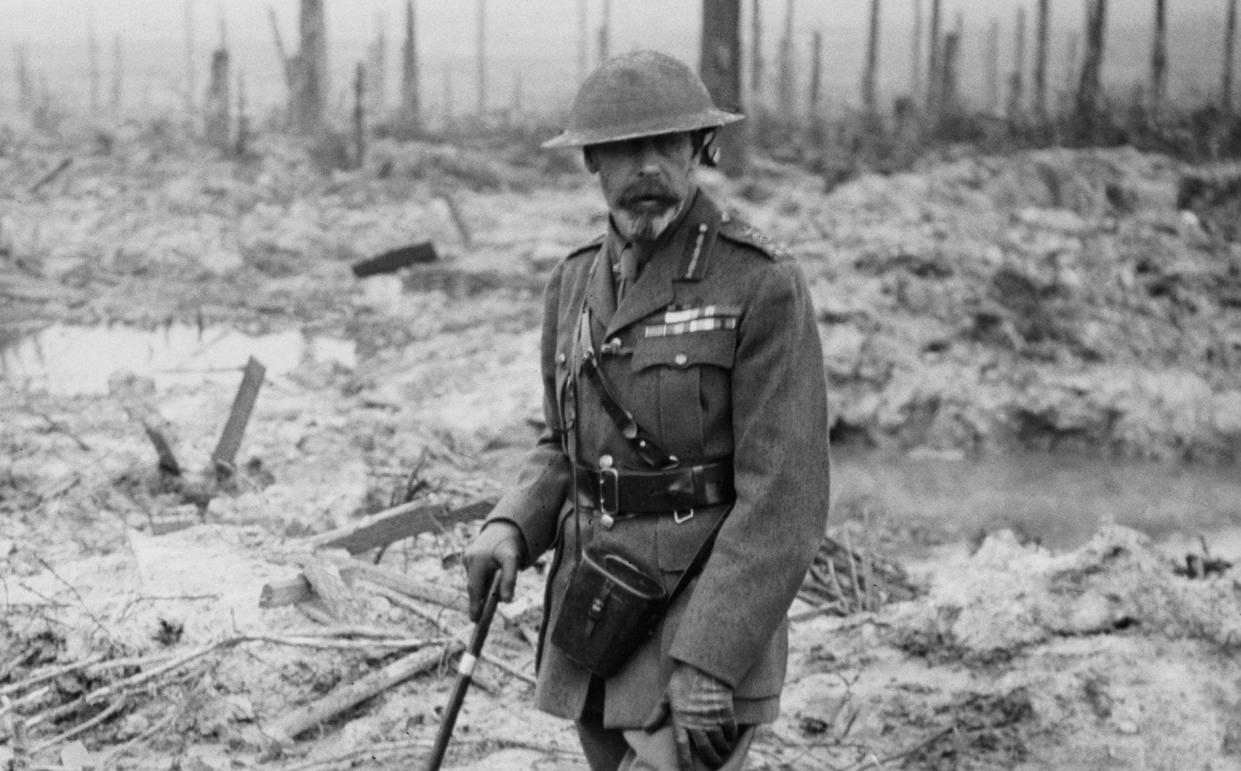For King and Country by Heather Jones, review: a monumental study of British royalty in WW1

- Oops!Something went wrong.Please try again later.
- Oops!Something went wrong.Please try again later.
- Oops!Something went wrong.Please try again later.
This is a necessary book. The role of the monarchy during the Great War has figured in passing in many histories and, in terms of the monarch himself, in Harold Nicolson’s authorised life of King George V and in Kenneth Rose’s unauthorised (and in many regards superior) one. For King and Country is a monumental study of British royalty in “the war to end all war”, with no archival stone left unturned: Heather Jones has exhaustively explored the impact of the King and his family on the national consciousness and the motivation of the war effort. The result is a dense but enriching work that adds much to the historiographical landscape of one of the most documented periods of our history.
Jones examines the King as an embodiment of the nation, the symbol for which men volunteered, fought and too often died. Through a process Jones calls “sacralisation”, society elevated the King to a mythological rank, in which he incarnated more than the country. He became a symbol of its values, the objective of its patriotism. Jones occasionally references Walter Bagehot, whose idea of a family on the throne with which the ordinary Briton could identify had never been so relevant as at this time. The Queen consort visited hospitals and indeed the battle area, and their two sons of military age served on the Western Front (the Prince of Wales) and at Jutland (Prince Albert, later King George VI). Servicemen received a brass box of chocolates at Christmas from Princess Mary, and on top of all that the King and his family renounced alcohol for the duration, something he was tricked into by Lloyd George and which confirmed his suspicions about that politician’s charlatanry. The King was tireless in meeting wounded soldiers, and saw terrible sights: “You can’t conceive what I suffered going round those hospitals in the war,” he said to a courtier afterwards. He would then put the horrors to one side by sorting out his stamp collection.
Jones examines the changing relationship between the monarchy and the country caused by war, and the nature of deference. Many who survived the war determined not to accept a return to the rigidities of the pre-war class system, but respect for the monarchy seemed to have been an exception. She is wrong to snipe at Sir Douglas Haig (who merits criticism on most other fronts) for his “sycophantism” [sic] in his own display of deference to the King: it shows a misunderstanding of the relationship between a very senior officer and the monarch whose Army he led, and of the etiquette of the times.
The King and Queen and their warrior sons ensured the popularity of the institution, and under the guiding hand of the King’s private secretary, Lord Stamfordham, were wise to do so. Republicanism reared its head in the British Isles with the Easter Rising and the advance of Sinn Féin, and widespread support for the Russian Revolution was something Stamfordham sought to ensure did not mutate into anti-monarchism here, not least by ensuring asylum in Britain was not granted to the Romanovs. The King also took the precaution of changing his German surname to “Windsor”.
However, what Jones calls the “narrative” of George V as a supporter of democracy pre-dates the revolution and indeed the war: he would not otherwise have agreed to a mass creation of peers if needed to pass the Parliament Bill in 1911. She analyses the King’s political power, and discusses the extent to which he was consulted, notably about senior military appointments, and about appeals to him from soldiers who felt they had suffered injustice; but it is what he symbolises that always matters most – his incarnation of honour, his role in investitures and his strong link to religion, being supreme governor of the Church of England. A superstition, albeit a benign one, grew up around the monarchy: rather like the “royal touch” of medieval times, the Royal family could bring joy and happiness wherever they went.
Sadly, this extensive work of scholarship is spoilt by a casual approach to fact, something that still has its place in historical writing. The first wartime coalition was formed in May, not December, 1915. F E Smith was never known as Frederick E Smith – which makes him sound like a Hollywood mogul – and he was not Earl of Birkenhead in 1916 when attorney general; he was Sir Frederick Smith. There is no such place as Stoney Massey; it is Stondon Massey. Curzon was not “foreign minister” in 1917; he was Foreign Secretary from 1919. And Balfour was not knighted until 1922, but getting an earldom at the same time he was never known as Sir Arthur Balfour. The Unknown Warrior is not called the Unknown Soldier. Nonetheless, this book is a deep study, and shows not least how the bedrock of the monarchy’s popularity today was painstakingly laid down.
To order a copy for £25.99, call 0844 871 1514 or visit Telegraph Books

